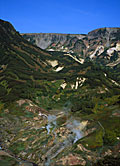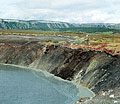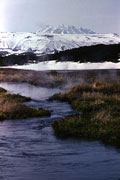Uzon-Geysernaia
twin calderas form a 9 x 18 km depression (Fig. 1), which
originated as a result of large explosive eruptions in the late
Pleistocene time. Associated ignimbrite sheet (Fig. 2) covers an area of
1700 km3. A single 14C date on a paleosol,
underlying the Uzon-Geysernaia pyroclastic deposits, suggests an age of
this eruption of 39 600±1000 BP (Florensky, 1984; Braitseva et al.,
1995).
The
northwestern part of the caldera (or Uzon caldera) hosts a large
geothermal field and numerous hot and cold lakes (Figs. 3 and 4).
Present geothermal activity is concentrated in a 0.2-0.3 x 5 km zone
filled with boiling springs, gas-steam jets, mudpots, small mud
volcanoes, hot lakes and springs with colonies of blue-green algae and
thiobacteria (Piip, 1937; Pilipenko,
1976; Karpov, 1992; Leonov et al., 1991). Some of the lakes are located in the
craters of phreatic eruptions. The most recent phreatic eruption
took place in 1989 and created a 14 m wide crater. The southeastern part
of the Uzon-Geysernaia caldera (or
Geysernaia caldera) is filled with dominantly late Pleistocene lava
domes (Fig. 1). A 4-km-long canyon of the Valley of Geysers (Figs. 1, 5
and 6) is
located near the eastern rim of the Geysernaia caldera and hosts
nearly 30 geysers, boiling springs, and mudpots. Each of the
geysers has its own regime: some erupt strong fountains of steam every
few minutes while others "work" once in 0.5-2 hours. The Valley of
Geysers was first discovered and described in 1941 by T.I.Ustinova
(Ustinova, 1955).
The Uzon caldera hosts a few Holocene volcanic vents. The only definitely
Holocene magmatic feature is a tuff ring filled with
Dalnee Lake (Fig. 7). The eruption took place 7.6-7.7 ka BP (Braitseva
et al., 1995). It produced dark-gray cinder
of medium-K tholeiitic
andesite composition.
Lava dome of
Mt. Belaia and its pumice tuff overlie glacial deposits, and are
overlain by the Holocene soil-pyroclastic cover, so Mt. Belaia likely formed in
the very end of late Pleistocene.
A number of phreatic
eruptions took place within the Uzon caldera during the Holocene time.
Some of those have been dated: a crater enclosing Khloridnoe Lake formed 1.5-2 ka BP; Bannoe Lake (Figs.
4 and 8) ~3.5 ka BP. Deposits from a
phreatic eruption with an age of 7.7 ka BP have been also identified but
their source is unknown (Egorova, 1993).
Uzon caldera displays a large variety of
thermal waters (Pilipenko, 1976). Boiling waters in the axial part of
the thermal field are commonly rich in boron, silicon, and ammonium
chloride and have high concentrations of alkali metals (Li, Rb, and Cs)
and ore elements (As, Sb and Hg). The rest of the hydrotherms are
sulfate-chloride-sodium, hydrocarbonate-sulfate-calcium-sodium and
hydrocarbonate ("narzans"). They are produced due to subsurface
differentiation and mixing of chloride-sodium and surface waters
(Karpov, 1988, 1992; Leonov et al., 1991). Spontaneous gases include CO2,
N2, H2, H2S and CH4. These
gases contain high concentrations of radon. Oil of
methane-naphthene-aromatic type was found in the thermal fields of the
Uzon caldera. Extraordinary high optical activity of the oil suggests
its biogenic nature (Volcanism..., 1974).
Two types of ore mineralization can be
distinguished within the Uzon caldera: sulfurous and
mercury-antimony-arsenic. Sulfurous type is represented by relics,
lenses and beach deposits of almost monomineral sulphur of a crater-lake
genesis contaminated by opal and clay minerals.
Mercury-antimony-arsenic type is represented by realgar-orpiment facies
(Leonov et al., 1991).
In spring, non-freezing lakes and rivers of
the Uzon caldera are visited by white swans (Figs. 9 and 10).
Literature
Braitseva O.A., Melekestsev I.V., Ponomareva V.V., and Sulerzhitsky L.D.
(1995) The ages of calderas, large explosive craters and active
volcanoes in the Kuril-Kamchatka region, Russia. Bull Volcanol 57/6:
383-402
Egorova
I. A. (1993) Age and paleogeography of the formation of
volcano-sedimentary deposits in the Uzon-Geizernaya caldera depression,
Kamchatka (according to palynological data).
Volcanol Seismol 15/2: 157-177
Florensky I.V. (1984) On the age of Uzon and Krasheninnikov calderas,
Volcanol Seismol, 1, 102-105 (In Russian)
Karpov G.A. (1988) Recent hydrothermal
springs and Hg-Sb-As mineralization. Moscow, Nauka Publishers, 183 pp
(In Russian)
Karpov G.A. (1992) Subsurface hydrothermal
genesis of ores and minerals in recent hydrothermal system of Uzon
caldera in Kamchatka, Russia. In: Water-Rock Interaction, Kharaka, Y.F.
and Maest, A.S., eds., Balkema, Rotterdam, v. 2, p. 1593-1596
Leonov V.L., Grib Ye.N., Karpov G.A.,
Sugrobov V.M., Sugrobova N.G., and Zubin M.I. (1991) Uzon caldera and
Valley of Geysers. In: Active Volcanoes of Kamchatka. Moscow, Nauka
Publishers, v. 2: 94-141
Piip B.I. (1937) Thermas of Kamchatka. Trudy
SOPS AN SSSR, ser. Kamchatskaya, iss.2, 268 pp. (In Russian)
Pilipenko G.F. (1976) Steam-hydrothermas of
Uzon caldera. In: Hydrothermal Systems and Thermal Fields of Kamchatka.
Vladivostok, pp.237-266 (In Russian)
Ustinova T.I. (1955) Geysers of Kamchatka.
Gosizdat Geographicheskaia Literatura, Moscow, 120 pp. (In Russian)
Volcanism, Hydrothermal Process and Ore
Formation (1974) Moscow, Nauka Publishers, 264 pp.









